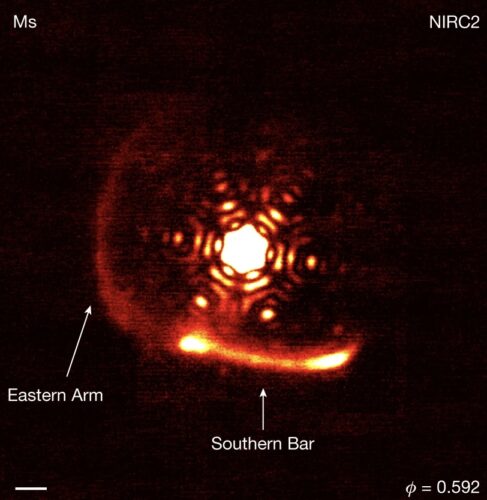Image courtesy of Yinuo Han & Peter Tuthill.
Imagine a rare, gigantic star scorching a second hot blue-white metallic star incessantly burning its fuel. Harsh cavalcades of photons shoot out from both stars in a dramatic, explosive dance. From both, spectacular stellar winds extend outwards, forming dust where the two winds collide. This phenomenon occurs in the eccentric WR140 binary system, providing astrophysicists with an exceptional example of cosmic dust formation.
While dust may be nothing more than a hygienic annoyance to us, it plays key roles in astrophysics, from the creation of nebulae to the formation of our solar system. Its complex geometries at colossal scales warrant further study on how they form. For the WR140 system, previous images by the Keck Observatory and, more recently, the James Webb Space Telescope showed a concentric shell pattern forming around the system. Interestingly, there appeared to be particular asymmetries in the dust shell geometry. The system’s uniqueness eluded previous geometric models of both the shells and their features, especially models that assumed uniformity in dust expansion rates.
Enter Yinuo Han, a graduate of the University of Sydney and now a third year at Cambridge University. Alongside University of Sydney professor Peter Tuthill, Han took the problem into his own hands—quite literally—by fitting and fine-tuning a novel model to account for the various intricacies of the system. His model included a plethora of new considerations about the WR140 system.
The eccentricity of the orbit, a measure of how stretched an ellipse is, means that dust production increases as the stars draw closer together. However, fascinatingly, his model also predicted that as the stars draw too close, dust production comes to a near-complete halt, explaining the lack of dust structures in certain directions from the system. Moreover, by modeling asymmetries at the conical wind collision front—the colliding boundary of both stellar winds which rotates over the orbit—Han could reproduce further dust features, or a lack thereof, in the Keck data. Lastly, Han discovered that the dust structures accelerated as they expanded, which could be accounted for by the strong radiation pressure from the stars’ light. With that, Han had one thing left to do: adjust parameters to fit the Keck imagery. “It turns out that most of the orbital parameters are tightly constrained by previous data, so [I was left] with only a handful of parameters to be tuned,” Han said. His cumulative model now accurately reflected the dynamics of the WR140 dust shell, which had not been revealed by previous imaging data.
With the WR140 chapter coming to a close, asking about his future plans yielded a rather witty, humble answer. “Right now, I just hope to complete my PhD,” Han said. Han now works on dust in less conspicuous systems—as he puts it, “normal star systems” not unlike our own Solar system. In such systems, belts of planetesimals and asteroids continuously collide and grind each other into dust and gas that are observable. Han’s techniques in analyzing the features and asymmetries of these dusty disks may help identify planetesimals and reveal the history of the system, such as how giant collisions and planetesimal collisions occur, a valuable contribution to exoplanetary science. This work, therefore, relates closely to understanding how planets form and evolve and their likelihood of hosting life, paving the way for explosive growth in our collective knowledge.

